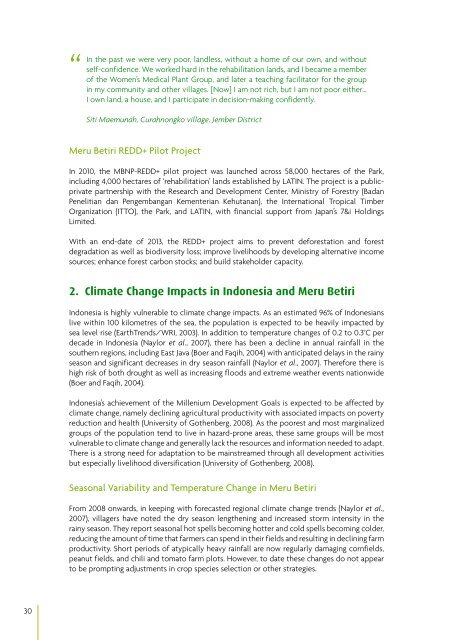Adaptation case studies.pdf - RECOFTC
Adaptation case studies.pdf - RECOFTC
Adaptation case studies.pdf - RECOFTC
You also want an ePaper? Increase the reach of your titles
YUMPU automatically turns print PDFs into web optimized ePapers that Google loves.
“In the past we were very poor, landless, without a home of our own, and withoutself-confidence. We worked hard in the rehabilitation lands, and I became a memberof the Women’s Medical Plant Group, and later a teaching facilitator for the groupin my community and other villages. [Now] I am not rich, but I am not poor either…I own land, a house, and I participate in decision-making confidently.Siti Maemunah, Curahnongko village, Jember DistrictMeru Betiri REDD+ Pilot ProjectIn 2010, the MBNP-REDD+ pilot project was launched across 58,000 hectares of the Park,including 4,000 hectares of ‘rehabilitation’ lands established by LATIN. The project is a publicprivatepartnership with the Research and Development Center, Ministry of Forestry (BadanPenelitian dan Pengembangan Kementerian Kehutanan), the International Tropical TimberOrganization (ITTO), the Park, and LATIN, with financial support from Japan’s 7&i HoldingsLimited.With an end-date of 2013, the REDD+ project aims to prevent deforestation and forestdegradation as well as biodiversity loss; improve livelihoods by developing alternative incomesources; enhance forest carbon stocks; and build stakeholder capacity.2. Climate Change Impacts in Indonesia and Meru BetiriIndonesia is highly vulnerable to climate change impacts. As an estimated 96% of Indonesianslive within 100 kilometres of the sea, the population is expected to be heavily impacted bysea level rise (EarthTrends/WRI, 2003). In addition to temperature changes of 0.2 to 0.3°C perdecade in Indonesia (Naylor et al., 2007), there has been a decline in annual rainfall in thesouthern regions, including East Java (Boer and Faqih, 2004) with anticipated delays in the rainyseason and significant decreases in dry season rainfall (Naylor et al., 2007). Therefore there ishigh risk of both drought as well as increasing floods and extreme weather events nationwide(Boer and Faqih, 2004).Indonesia’s achievement of the Millenium Development Goals is expected to be affected byclimate change, namely declining agricultural productivity with associated impacts on povertyreduction and health (University of Gothenberg, 2008). As the poorest and most marginalizedgroups of the population tend to live in hazard-prone areas, these same groups will be mostvulnerable to climate change and generally lack the resources and information needed to adapt.There is a strong need for adaptation to be mainstreamed through all development activitiesbut especially livelihood diversification (University of Gothenberg, 2008).Seasonal Variability and Temperature Change in Meru BetiriFrom 2008 onwards, in keeping with forecasted regional climate change trends (Naylor et al.,2007), villagers have noted the dry season lengthening and increased storm intensity in therainy season. They report seasonal hot spells becoming hotter and cold spells becoming colder,reducing the amount of time that farmers can spend in their fields and resulting in declining farmproductivity. Short periods of atypically heavy rainfall are now regularly damaging cornfields,peanut fields, and chili and tomato farm plots. However, to date these changes do not appearto be prompting adjustments in crop species selection or other strategies.30
















